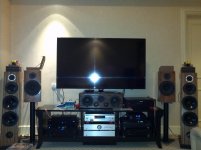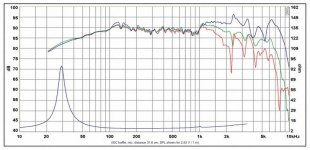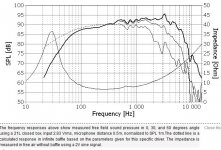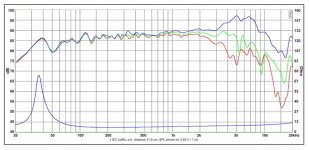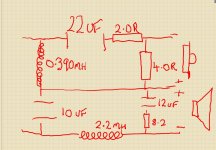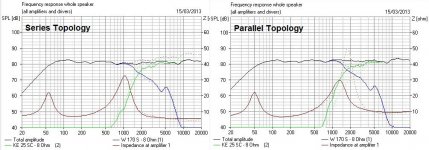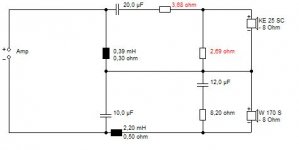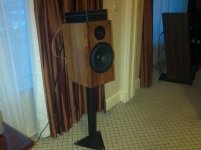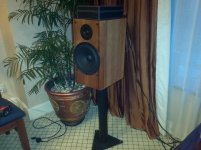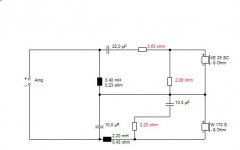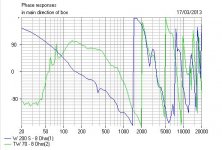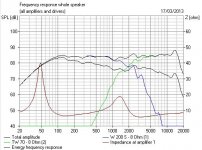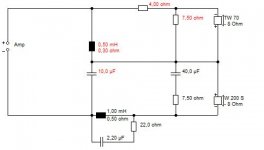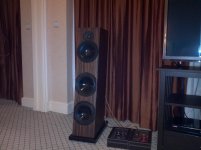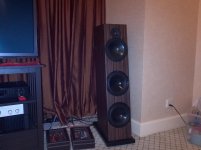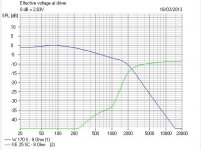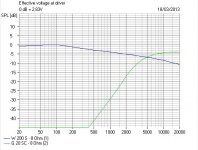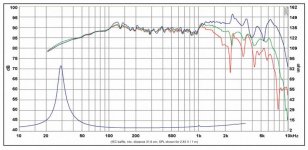Very interesting, chefsinc, but reading Troels Gravesen's 8" plus 1" project, I am shocked just how hard it is to deal with the 3.5kHz resonance of 8" woofers.
8555-7100
I throw in the new SEAS 8" polycone for comparison along with a 6" SB Acoustics woofer.
A 1.7kHz crossover is VERY low for most tweeters. You're gonna get some cone breakup or tweeter Fs IM distortion for sure. 6" woofer is much easier to deal with around 5kHz cone breakup. But I look forward to seeing your schematic. 🙂
8555-7100
I throw in the new SEAS 8" polycone for comparison along with a 6" SB Acoustics woofer.
A 1.7kHz crossover is VERY low for most tweeters. You're gonna get some cone breakup or tweeter Fs IM distortion for sure. 6" woofer is much easier to deal with around 5kHz cone breakup. But I look forward to seeing your schematic. 🙂
Attachments
Hi Chefsinc,
Can you buy SB Acoustics's Satori mid/woofer driver in Indonesia? If yes do you know the price?
Can you buy SB Acoustics's Satori mid/woofer driver in Indonesia? If yes do you know the price?
Very interesting, chefsinc, but reading Troels Gravesen's 8" plus 1" project, I am shocked just how hard it is to deal with the 3.5kHz resonance of 8" woofers.
8555-7100
I throw in the new SEAS 8" polycone for comparison along with a 6" SB Acoustics woofer.
A 1.7kHz crossover is VERY low for most tweeters. You're gonna get some cone breakup or tweeter Fs IM distortion for sure. 6" woofer is much easier to deal with around 5kHz cone breakup. But I look forward to seeing your schematic. 🙂
Correct about that. just when i think i have nailed the crossover the resonance raises its ugly head. other option is to also put a notch as troels has done but i am trying to do with limited components first.
I know a lot of people stay away from 8" drivers for 2 ways but I just love the way they fill a room with music like no 6" can. Plus I like torturing myself with these challenges
Dear Gurus,
Can a pioneer AV amp with MCACC program and microphone measure effectively or is it a bit of hit and miss.
I ran the mcacc sweep over my speakers with latest crossover and it is telling me they are flat from about 200hz to 10000hz give or take between .5 to 2db all the way.
Not sure if this is a reliable source for measurements but I was pretty happy with that.
before I did the measurement, I was listening and said to myself that it sounds bloody good. It was a very refined sound listening to Andrea Boccelli to me it sounded Smooth as silk.
Can a pioneer AV amp with MCACC program and microphone measure effectively or is it a bit of hit and miss.
I ran the mcacc sweep over my speakers with latest crossover and it is telling me they are flat from about 200hz to 10000hz give or take between .5 to 2db all the way.
Not sure if this is a reliable source for measurements but I was pretty happy with that.
before I did the measurement, I was listening and said to myself that it sounds bloody good. It was a very refined sound listening to Andrea Boccelli to me it sounded Smooth as silk.
]Dear fellow ear tinglers,
I have got to a point with the crossover where I am relatively happy as a base for future tweaking. Basically It was tuned by ear and many sleepless nights on how to get it to this point. I have attached the hand drawn schematic of the crossover if anyone wants to simulate it for me and tell me where I can improve on it technically.😀
This may sound a little cowboyish but I tried closed box, vented box and I have now chosen to fill the cabinets with polyfill and actually remove the port tube and leave the hole unsealed. the poly fill covers the remaining hole, this gave me the best deeper bass and it sort of recreates a variovent.😕
The hand drawn schematic was done on a galaxy note, so please all you fancy pants with the computer generated programs do not drag me over the coals for the primitive sketch.
So to recap the box is 26lts. series crossover, no port tube nor sealed.
Hope you like it and I hope someone is interested enough to have a go of these superb drivers, you will not regret it.
thanks
Jonathan
I have got to a point with the crossover where I am relatively happy as a base for future tweaking. Basically It was tuned by ear and many sleepless nights on how to get it to this point. I have attached the hand drawn schematic of the crossover if anyone wants to simulate it for me and tell me where I can improve on it technically.😀
This may sound a little cowboyish but I tried closed box, vented box and I have now chosen to fill the cabinets with polyfill and actually remove the port tube and leave the hole unsealed. the poly fill covers the remaining hole, this gave me the best deeper bass and it sort of recreates a variovent.😕
The hand drawn schematic was done on a galaxy note, so please all you fancy pants with the computer generated programs do not drag me over the coals for the primitive sketch.

So to recap the box is 26lts. series crossover, no port tube nor sealed.
Hope you like it and I hope someone is interested enough to have a go of these superb drivers, you will not regret it.
thanks
Jonathan
Attachments
Last edited:
sorry David, I should have been more elaborate.
the + input issue top left corner between the .390 inductor and 22 if capacitor
the - output to amp is bottom left corner between the 10uf capacitor and the 2.2mh inductor
the + input issue top left corner between the .390 inductor and 22 if capacitor
the - output to amp is bottom left corner between the 10uf capacitor and the 2.2mh inductor
Incredibly impressive piece of tuning by ear, chefsinc! Series too. 😎
I just ran this past Boxsim with some vaguely similar drivers and got a good result by twiddling the resistors on the treble section. Phase alignment was good between 1kHz and 5kHz too. The 22uF can be changed to 15uF with little impact. 😀
Really can't comment on polarity here, since it depends on the depth of the woofer, and your breakup peak will be at about 3.5kHz rather than 5kHz, but you have the potential for a good result there, IMO. Nice work. You are gifted.
I just ran this past Boxsim with some vaguely similar drivers and got a good result by twiddling the resistors on the treble section. Phase alignment was good between 1kHz and 5kHz too. The 22uF can be changed to 15uF with little impact. 😀
Really can't comment on polarity here, since it depends on the depth of the woofer, and your breakup peak will be at about 3.5kHz rather than 5kHz, but you have the potential for a good result there, IMO. Nice work. You are gifted.
Attachments
Wow. System 7 thankyou so very much for your appreciative response to my Humble creation.
My wife would not say i was gifted but Anal to the ooint where I will switch off for days to problem solve the desired result.
And thankyou for taking the time out of your day to simulate for me.
I will deinatley try the 15uf cap on tweeter and let you know.
once again thanks and cheers
regards
Jonathan
My wife would not say i was gifted but Anal to the ooint where I will switch off for days to problem solve the desired result.
And thankyou for taking the time out of your day to simulate for me.
I will deinatley try the 15uf cap on tweeter and let you know.
once again thanks and cheers
regards
Jonathan
The Finished Batavia's.
I am really happy with these guys. superb drivers. Amazing midrange , sweet treble and bass is fantastic. Tight dry without the boominess you would expect from a no port, unsealed design. I took a risk with this alignment but it has paid off with the huge smile on my dial.🙂🙂🙂🙂🙂
next project better stands for these babies.
cheers all for your input.
regards
Jonathan
I am really happy with these guys. superb drivers. Amazing midrange , sweet treble and bass is fantastic. Tight dry without the boominess you would expect from a no port, unsealed design. I took a risk with this alignment but it has paid off with the huge smile on my dial.🙂🙂🙂🙂🙂
next project better stands for these babies.
cheers all for your input.
regards
Jonathan
Attachments
I was playing with values a bit more this morning. It does seem to prefer drivers in phase on a flattish baffle.
Seems the 8.2 ohm resistor on the Woofer "Zobel" controls rolloff. Making it a smaller 3.3 ohms gives you about 6dB less cone breakup and deeper rolloff. Going lower than 3.3 ohms starts to worsen phase alignment and creates a midrange bump on the woofer as you might expect. 10 or 12uF here makes little difference.
Changing the 0.39mH to 0.3mH (along with 22uF going to 15uF) raises the crossover point a tidge nearer 2kHz and lowers the level at which the tweeter Fs resonance occurs by about 4dB.
A very nice circuit. Hope those comments help you get a feel for what any changes achieve, and I'm not even suggesting anything needs changing. Of course that analysis is not exact, because I used different drivers, but the circuit seems to fall in a nice point of stability, where nothing is too critical on values. One of the better threads here, Jonathan. I learned something. Thankyou. 😎
Seems the 8.2 ohm resistor on the Woofer "Zobel" controls rolloff. Making it a smaller 3.3 ohms gives you about 6dB less cone breakup and deeper rolloff. Going lower than 3.3 ohms starts to worsen phase alignment and creates a midrange bump on the woofer as you might expect. 10 or 12uF here makes little difference.
Changing the 0.39mH to 0.3mH (along with 22uF going to 15uF) raises the crossover point a tidge nearer 2kHz and lowers the level at which the tweeter Fs resonance occurs by about 4dB.
A very nice circuit. Hope those comments help you get a feel for what any changes achieve, and I'm not even suggesting anything needs changing. Of course that analysis is not exact, because I used different drivers, but the circuit seems to fall in a nice point of stability, where nothing is too critical on values. One of the better threads here, Jonathan. I learned something. Thankyou. 😎
Attachments
Fantastic work S7.
I have a spare test circuit in which i can swap over quite rapidly. I will definately try all your suggestions. I am grateful and really impressed you take the time to perfect "our design".
As I type I am playing Supertramp best of and got to tell you I am so excited. Its like hearing it for the first time again as I did in the late 70's when my parents were hip and happenning.
Thankyou so very much for your input and sage knowledge on improving the crossover.
cheers
I have a spare test circuit in which i can swap over quite rapidly. I will definately try all your suggestions. I am grateful and really impressed you take the time to perfect "our design".
As I type I am playing Supertramp best of and got to tell you I am so excited. Its like hearing it for the first time again as I did in the late 70's when my parents were hip and happenning.
Thankyou so very much for your input and sage knowledge on improving the crossover.
cheers
Well, if you seriously wanted to raise the crossover point, you'd change the 10uF caps to 6.8uF as well. I'm not sure whether you want to do that with such good tweeters and such a big woofer. 🙂
But the 8.2R replaced by 3.3R seems a good and simple thing to try. 🙂
FWIW, here's Joachim Gerhard's current design for his Satori project, which uses a different woofer. He's always interesting.
http://www.diyaudio.com/forums/vendors-bazaar/220330-sb-acoustics-satori-monitor.html
But the 8.2R replaced by 3.3R seems a good and simple thing to try. 🙂
FWIW, here's Joachim Gerhard's current design for his Satori project, which uses a different woofer. He's always interesting.
http://www.diyaudio.com/forums/vendors-bazaar/220330-sb-acoustics-satori-monitor.html
Attachments
My design is an acoustic all pass with 12dB octave.
That requires to turn the absolute phase on the tweeter.
I use a rather high value resistor before the tweeter and not the more common voltage divider. That way the impedance in the treble is high and i can use a rather small cap before the tweeter. That safes cost or you could invest in a better quality cap.
I got great results with the new Mundorf EVO.
That requires to turn the absolute phase on the tweeter.
I use a rather high value resistor before the tweeter and not the more common voltage divider. That way the impedance in the treble is high and i can use a rather small cap before the tweeter. That safes cost or you could invest in a better quality cap.
I got great results with the new Mundorf EVO.
Aw, Joachim...I thought you were going to help us out here! 😀
I have a passing interest in the 8" plus 1" idea after buying these golden oldies, Monitor Audio R300/MD :
Out of the box they came with a single woofer coil and a second order tweeter, and I added the Zobel:
The fact is that typical 3.5kHz 8" cone resonance makes anything but a low 2kHz crossover almost impossible unless you can accept some cone-breakup on a low order bass filter. Which makes BIG demands on the tweeter, which must also be EFFICIENT so you can use a tweeter attenuator with a series filter.
I found a 4 ohm woofer was easier to do, but here's some modelling of series and parallel topologies with the high-inductance 8" Visaton W200S. Amazingly, the bass section is pretty damn similar. Notches (here, a tank @ 3.5kHz) can be incorporated in series filters as easily as parallel. The 22uF optional tweeter capacitor turns out to just do some DC blocking. It's not strictly required.
Lastly that decent Eltim design for 6" Morel polycones around 2kHz. Hope you get the idea. 🙂
I have a passing interest in the 8" plus 1" idea after buying these golden oldies, Monitor Audio R300/MD :
An externally hosted image should be here but it was not working when we last tested it.
Out of the box they came with a single woofer coil and a second order tweeter, and I added the Zobel:
An externally hosted image should be here but it was not working when we last tested it.
The fact is that typical 3.5kHz 8" cone resonance makes anything but a low 2kHz crossover almost impossible unless you can accept some cone-breakup on a low order bass filter. Which makes BIG demands on the tweeter, which must also be EFFICIENT so you can use a tweeter attenuator with a series filter.
I found a 4 ohm woofer was easier to do, but here's some modelling of series and parallel topologies with the high-inductance 8" Visaton W200S. Amazingly, the bass section is pretty damn similar. Notches (here, a tank @ 3.5kHz) can be incorporated in series filters as easily as parallel. The 22uF optional tweeter capacitor turns out to just do some DC blocking. It's not strictly required.
Lastly that decent Eltim design for 6" Morel polycones around 2kHz. Hope you get the idea. 🙂
Attachments
-
 Morel_CAT-298_Fs.JPG48.1 KB · Views: 209
Morel_CAT-298_Fs.JPG48.1 KB · Views: 209 -
 6_Parallel_Crossover_Phase.JPG54.7 KB · Views: 141
6_Parallel_Crossover_Phase.JPG54.7 KB · Views: 141 -
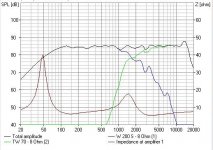 5_Parallel_Topology_FR.jpg84.2 KB · Views: 180
5_Parallel_Topology_FR.jpg84.2 KB · Views: 180 -
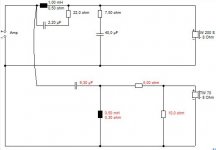 4_Parallel_Topology_Circuit.jpg33.6 KB · Views: 179
4_Parallel_Topology_Circuit.jpg33.6 KB · Views: 179 -
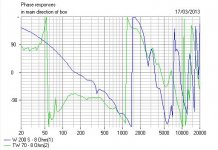 3_Series_crossover_phase.JPG55.1 KB · Views: 146
3_Series_crossover_phase.JPG55.1 KB · Views: 146 -
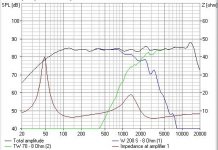 2_Series_Topology_FR.jpg83.9 KB · Views: 222
2_Series_Topology_FR.jpg83.9 KB · Views: 222 -
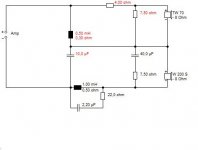 1_Series_Topology_Circuit.jpg28.6 KB · Views: 280
1_Series_Topology_Circuit.jpg28.6 KB · Views: 280
Last edited:
I just noticed that the phase for the series (3) is a LOT poorer than for the Parallel (6). 😕
I forgot to mention something Joachim Gerhard knows well. These series circuits work best TIME-ALIGNED. Swap the tweeter phase and set it back level with the woofer:
Job done. Much better. 😀
I forgot to mention something Joachim Gerhard knows well. These series circuits work best TIME-ALIGNED. Swap the tweeter phase and set it back level with the woofer:
An externally hosted image should be here but it was not working when we last tested it.
Job done. Much better. 😀
Attachments
S7.
yes I did sort of work that out after some days listening.
I have reverted to positive polarity on the tweeter and tilted the boxes back about 7 Degrees.
sounds much better and sound stage is more defined.
those monitor audio's are beauties, I think they use a focal woofer.
I am really happy with the way they sound now.
I didn't lower the crossover point as per the woofer breakup, but I did change the resistor from 8.2 to 3.9r and it seems to changed the sound slightly for the better.
I have been fiddling also with my no.2 floorstanders, that feature an 8" mid range and to parallel woofers for based duties. I just received my new HDS Scan speak tweeter and installed so was also changing the crossover. It seems to have integrated well with the 8"inch peerless mid range. crossover point is higher as this polyprop 8" doesn't have severe breakup at 3.5khz but much further up. Its a lovely woofer to work with.
Thanks S7 For your really valuable contribution.
thanks Joachim for stopping by.
regards
yes I did sort of work that out after some days listening.
I have reverted to positive polarity on the tweeter and tilted the boxes back about 7 Degrees.
sounds much better and sound stage is more defined.
those monitor audio's are beauties, I think they use a focal woofer.
I am really happy with the way they sound now.
I didn't lower the crossover point as per the woofer breakup, but I did change the resistor from 8.2 to 3.9r and it seems to changed the sound slightly for the better.
I have been fiddling also with my no.2 floorstanders, that feature an 8" mid range and to parallel woofers for based duties. I just received my new HDS Scan speak tweeter and installed so was also changing the crossover. It seems to have integrated well with the 8"inch peerless mid range. crossover point is higher as this polyprop 8" doesn't have severe breakup at 3.5khz but much further up. Its a lovely woofer to work with.
Thanks S7 For your really valuable contribution.
thanks Joachim for stopping by.
regards
Attachments
Last edited:
Very interesting thread, Jonathan. I think you've got them about as good as is possible. 🙂
This Robin Marshall circuit (or Joachim Gerhard's time-aligned, which is not a million miles away...) just won't work with your bass drivers.
It relies on some natural rolloff on the bass, or at least no raised cone-breakup peaks. You don't have that with the 8'' SB23NRXS45-8. The electrical response of your circuit shows how it does more than the simple Monitor Audio one.
Interesting for me, that the original Robin Marshall design is about as good as it gets with a difficult 8" driver, and everything I did to them apart from the tweeter Zobel really made them worse. Respect. 😎
This Robin Marshall circuit (or Joachim Gerhard's time-aligned, which is not a million miles away...) just won't work with your bass drivers.
An externally hosted image should be here but it was not working when we last tested it.
It relies on some natural rolloff on the bass, or at least no raised cone-breakup peaks. You don't have that with the 8'' SB23NRXS45-8. The electrical response of your circuit shows how it does more than the simple Monitor Audio one.
Interesting for me, that the original Robin Marshall design is about as good as it gets with a difficult 8" driver, and everything I did to them apart from the tweeter Zobel really made them worse. Respect. 😎
Attachments
- Status
- Not open for further replies.
- Home
- Loudspeakers
- Multi-Way
- SB ACOUSTICS TW29R & SB23NRXS4
